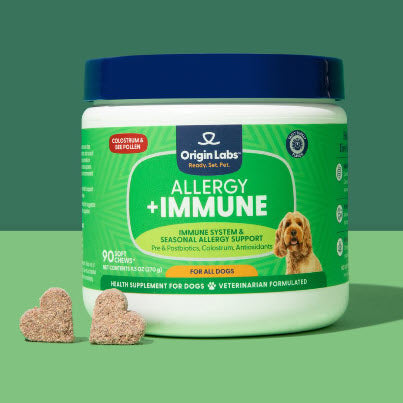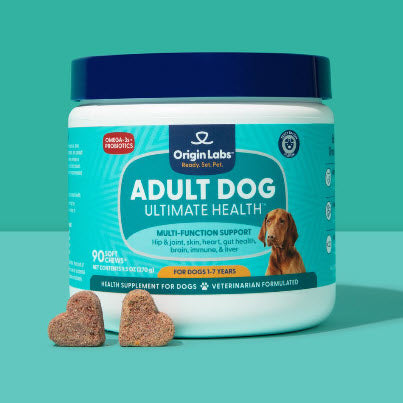Introduction
Can dogs eat licorice? This question has sparked considerable debate among pet owners. Licorice, commonly found in candy and herbal remedies, often raises concerns due to its potential health risks for dogs. The safety of licorice consumption by dogs remains controversial, causing confusion and worry among dog owners.
Understanding the potential risks and benefits of licorice is crucial before offering it to your dog as a treat or supplement. Some believe that licorice root extract may offer health benefits for dogs, such as anti-inflammatory and antimicrobial properties. However, the presence of harmful substances like glycyrrhizin in black licorice and xylitol in sugar-free versions poses significant health risks.
Grasping these nuances ensures that you make informed decisions about your dog's diet. To further support your dog's age, consider incorporating the best puppy health supplements for growing puppies or hip & joint supplements for senior dogs, into their diet.
Understanding Licorice and its Variants
Definition of Licorice
Licorice comes from the root of the Glycyrrhiza glabra plant, which is native to Europe and parts of Asia. It has been used for centuries in herbal remedies due to its medicinal properties. The sweet taste of licorice comes from a compound called glycyrrhizin, which is much sweeter than sugar.
Historical Usage
Licorice has a rich history, dating back to ancient civilizations:
- Ancient Egypt: Used in teas for its healing properties.
- Traditional Chinese Medicine: Employed as a harmonizer, balancing other herbs in formulations.
- Greek and Roman Cultures: Valued for its ability to soothe coughs and sore throats.
Modern Applications
Nowadays, licorice is utilized in various forms:
- Candies: Especially popular in black licorice confections.
- Herbal Supplements: Incorporated into capsules, teas, and tinctures aimed at digestive health and respiratory conditions.
- Flavoring Agent: Found in beverages like root beer and certain alcoholic drinks.
Key Components
Licorice root contains several active compounds:
- Glycyrrhizin: Responsible for its characteristic sweetness and potential health benefits but can cause side effects if consumed in large amounts.
- Flavonoids: Plant-based compounds with antioxidant properties.
- Coumarins: Known for their anti-inflammatory effects.
Health Benefits
Licorice root is believed to offer several health benefits:
- Anti-inflammatory Properties: Helps reduce inflammation and may aid conditions like arthritis.
- Antimicrobial Effects: Can combat various bacteria and viruses.
- Digestive Aid: Often used to alleviate symptoms of indigestion and gastric ulcers.
In summary, licorice is a multifaceted plant with a deep-rooted history in traditional medicine and modern applications across food and wellness industries.
Black Licorice vs. Red Licorice
Both black and red licorice are popular treats, but they have some important differences:
- Black Licorice: This type of licorice usually contains real licorice root extract, which contains glycyrrhizin. This gives black licorice its distinct flavor and may offer some potential health benefits, but it also carries certain risks.
- Red Licorice: On the other hand, red licorice typically does not contain licorice root extract. Instead, it gets its flavor from other ingredients like strawberry or cherry and is often colored with artificial dyes.
Licorice-Flavored Jelly Beans
It's worth noting that licorice-flavored jelly beans don't always contain actual licorice ingredients. Most commercially available jelly beans get their taste from artificial sources rather than using real licorice root extract. This difference is important when considering any possible health effects.
Being aware of the ingredients in treats and supplements is crucial in ensuring that you prioritize your dog's well-being effectively.
The Potential Risks of Licorice for Dogs
Glycyrrhizin Toxicity in Dogs
Licorice, especially black licorice, contains a compound called glycyrrhizin. This component gives licorice its sweet taste but can be very dangerous for dogs. Glycyrrhizin can cause several health problems:
- Impact on Blood Pressure: Glycyrrhizin affects how the body regulates sodium and potassium levels. This imbalance can raise blood pressure, which is especially risky for dogs with existing heart conditions.
- Electrolyte Imbalance: The disruption of sodium and potassium balance can also lead to muscle weakness, tiredness, and irregular heartbeats. In severe cases, it may even cause the heart to stop.
Xylitol Poisoning
Many sugar-free licorice products contain xylitol, an artificial sweetener that is highly toxic to dogs. Even small amounts can cause serious health issues:
Hypoglycemia (Low Blood Sugar): Xylitol triggers a sudden release of insulin in dogs, leading to a rapid drop in blood sugar levels. This condition can appear within 30 minutes of ingestion and could be deadly if not treated promptly.
Symptoms of Xylitol Poisoning:
- Vomiting
- Loss of coordination
- Seizures
- Coma
Symptoms of Licorice Ingestion in Dogs
If your dog happens to eat licorice candy, certain symptoms may indicate that they are having a negative reaction or experiencing toxicity:
Gastrointestinal Issues:
- Vomiting and diarrhea are common signs that your dog's digestive system is not handling the licorice well. These symptoms can lead to dehydration if they persist, so it's crucial to monitor your dog closely.
- Stomach cramps and abdominal discomfort might also occur, making your dog appear restless or in pain.
Increased Thirst and Urination:
- These symptoms might suggest an electrolyte imbalance or kidney stress caused by glycyrrhizin. You may notice your dog drinking more water than usual and needing frequent potty breaks.
- This increased urination can exacerbate dehydration, particularly if accompanied by vomiting or diarrhea.
Lethargy and Weakness:
- These could indicate a more severe reaction such as hypoglycemia due to xylitol poisoning or other metabolic disturbances. Your dog may seem unusually tired, unwilling to move, or show signs of muscle weakness.
- In severe cases, lethargy can escalate to complete inactivity or an inability to stand, signaling a medical emergency.
- By keeping an eye out for these symptoms, you can take prompt action and seek veterinary care if needed, ensuring the best possible outcome for your furry friend.
Key Points to Monitor
When keeping an eye on your dog after they have potentially eaten licorice, watch out for the following important signs:
- Behavioral Changes: Unusual tiredness or hyperactivity could be red flags.
- Physical Symptoms: Pay attention to any changes in appetite, water intake, or urination patterns.
If you suspect that your dog has consumed licorice containing harmful substances like glycyrrhizin or xylitol, it is crucial to seek immediate veterinary attention.
Understanding these risks can help prevent serious health problems related to licorice consumption in dogs.
Exploring Potential Benefits of Licorice Root Extract for Dogs
Licorice root extract has several health benefits for dogs, mainly because it:
- Has anti-inflammatory properties
- Contains substances that can fight against harmful microorganisms (known as antimicrobial properties)
Anti-Inflammatory Properties
Licorice root extract is well-known for its ability to reduce inflammation. This makes it especially useful in treating conditions that involve inflammation. For example, dogs with gastrointestinal inflammation can find relief by consuming licorice root extract. The soothing nature of the extract helps to decrease irritation and swelling in the digestive system. As a result, it promotes better digestion and provides comfort to the dog.
Antimicrobial Effects
One of the significant advantages of licorice root extract is its ability to fight against microorganisms. This property can be particularly beneficial for dogs dealing with respiratory infections or other bacterial problems. The antimicrobial components present in licorice root extract actively work to combat harmful bacteria. This action can potentially lead to faster recovery times and an improvement in overall health.
Specific Conditions Benefited by Licorice Root Extract
Licorice root extract may prove helpful in managing several specific conditions:
- Gastrointestinal Inflammation: The anti-inflammatory properties help soothe the digestive system.
- Respiratory Infections: The antimicrobial effects can aid in fighting off bacteria causing respiratory issues.
- Skin Irritations: Applying licorice root topically can reduce redness and itching due to its soothing properties.
Using licorice root extract could offer a natural remedy for these common canine ailments, making it a valuable addition to their overall health regimen.
Considerations for Safely Using Licorice with Dogs
Consulting with a Veterinarian
Before introducing licorice, especially in the form of concentrated extracts or supplements, it's essential to consult with a veterinarian. Each dog has unique health needs and conditions, and a vet can provide personalized advice on whether licorice is safe for them. They can also guide you on the appropriate dosage and monitor any potential side effects.
Alternative Natural Remedies
There are numerous natural remedies and dietary approaches that can support similar health goals for dogs without the risks associated with licorice use:
- Chamomile: Known for its calming properties and ability to soothe gastrointestinal issues.
- Ginger: Effective in treating nausea and improving digestion.
- Turmeric: Has anti-inflammatory properties that can help with joint pain and inflammation.
These alternatives can be safer options while still offering health benefits.
Moderation is Key
When introducing any new food or treat, including licorice-flavored products considered safe for canine consumption, moderation is crucial. Even if a product does not contain harmful ingredients like glycyrrhizin or xylitol, excessive consumption can lead to adverse health effects. Start with small amounts and observe how your dog reacts before considering regular inclusion in their diet.
Recommended Forms and Dosages
For those considering licorice root extract, it's important to know the recommended forms and dosages:
- Forms: Licorice root extract is available in various forms such as powders, liquid extracts, and capsules.
- Dosages: The dosage varies based on the dog’s weight, age, and overall health. A veterinarian can provide specific recommendations tailored to your dog's needs.
Careful attention to these details ensures that any potential benefits are maximized while minimizing risks.
Incorporating these considerations helps ensure the safe use of licorice for dogs, providing peace of mind for pet owners who want the best for their furry friends.
Conclusion
Licorice candy, particularly those containing glycyrrhizin or xylitol, should be avoided to protect the well-being of dogs. The potential risks posed by these substances far outweigh any minor benefits that might come from licorice root extract in other forms.
Focus on your dog's overall diet and nutrition as the foundation for good health. Rather than relying on specific ingredients like licorice root extract, consider a balanced and nutritious diet to support their well-being. High-quality dog food designed to meet all nutritional needs is often the best approach.
Always seek professional veterinary advice for any health concerns or treatment decisions regarding your furry companions. Your vet can provide personalized recommendations based on your dog's unique health profile and needs, ensuring they stay happy and healthy without unnecessary risks.
Remember: when it comes to treats and supplements, moderation is key. Treats should complement a balanced diet and not replace essential nutrients. Always keep an eye on ingredient lists and stay informed about what is safe for your dog to consume.
FAQs (Frequently Asked Questions)
Can dogs eat licorice?
Licorice, especially those containing glycyrrhizin or xylitol, should be avoided in order to protect the well-being of dogs. It is important to prioritize a dog's overall diet and nutrition as the foundation for good health, rather than relying on potential benefits from specific ingredients like licorice root extract.
What are the potential risks of licorice for dogs?
The harmful effects of glycyrrhizin on dogs' health include its impact on blood pressure and electrolyte balance. Additionally, xylitol, a common sweetener in sugar-free licorice products, can cause severe hypoglycemia in dogs. If a dog ingests licorice candy, they may experience symptoms such as vomiting, diarrhea, or increased thirst.
What are the potential benefits of licorice root extract for dogs?
Licorice root extract may offer potential health benefits to dogs, particularly its anti-inflammatory and antimicrobial properties. It could potentially be helpful in addressing specific conditions or issues in dogs, such as gastrointestinal inflammation or respiratory infections.
Is it safe to use licorice with dogs?
It is important for dog owners to consult with a veterinarian before giving licorice to their dog, especially if it's in the form of a concentrated extract or supplement. Alternative natural remedies or dietary approaches that can support similar health goals in dogs without the potential risks associated with licorice use should also be considered. Dog owners should emphasize moderation when offering any new food or treat to their dog.
What is the difference between black licorice and red licorice?
Black licorice typically contains glycyrrhizin, while red licorice is usually made without licorice root extract. It's important to differentiate between these variants and be cautious about offering black licorice to dogs due to the potential harmful effects of glycyrrhizin.
Where does licorice come from and how is it used?
Licorice comes from the roots of the Glycyrrhiza glabra plant and has been used in confectionery products as well as herbal remedies for humans. It's important for dog owners to understand this background and avoid offering licorice-based products that could be harmful to their pets.








